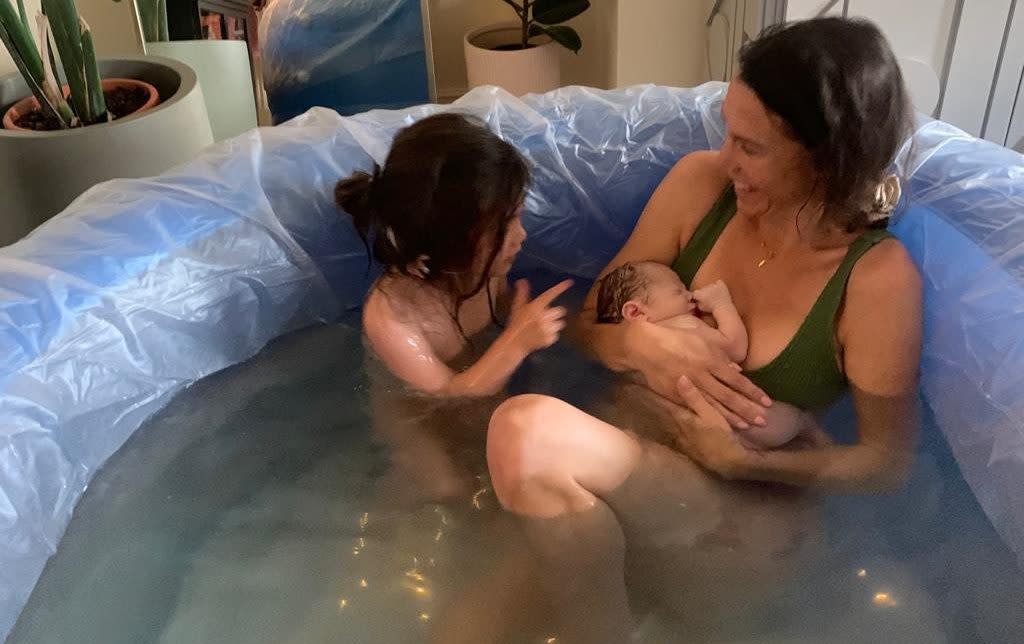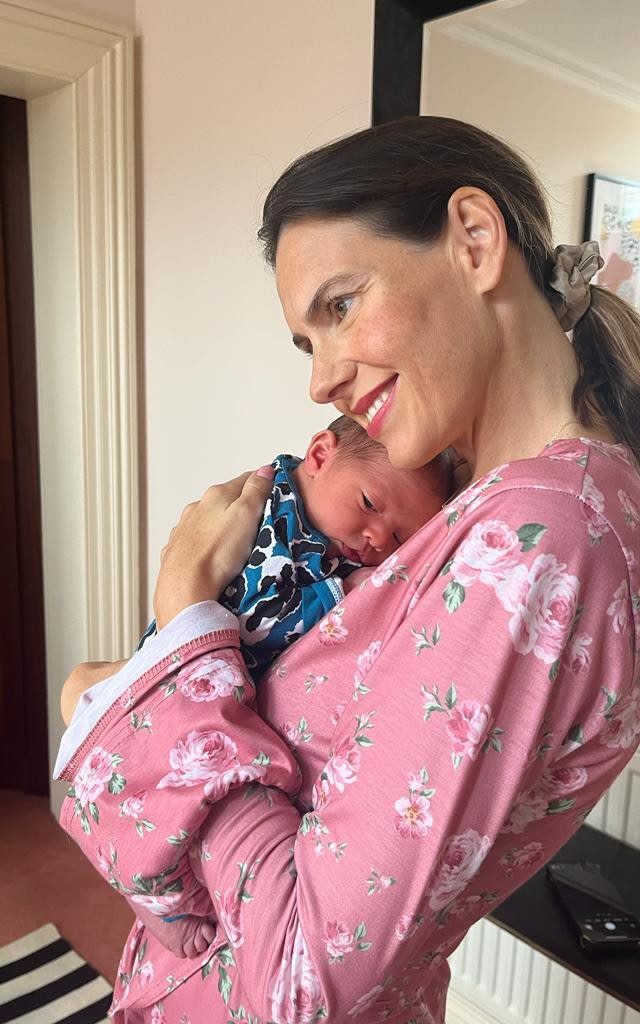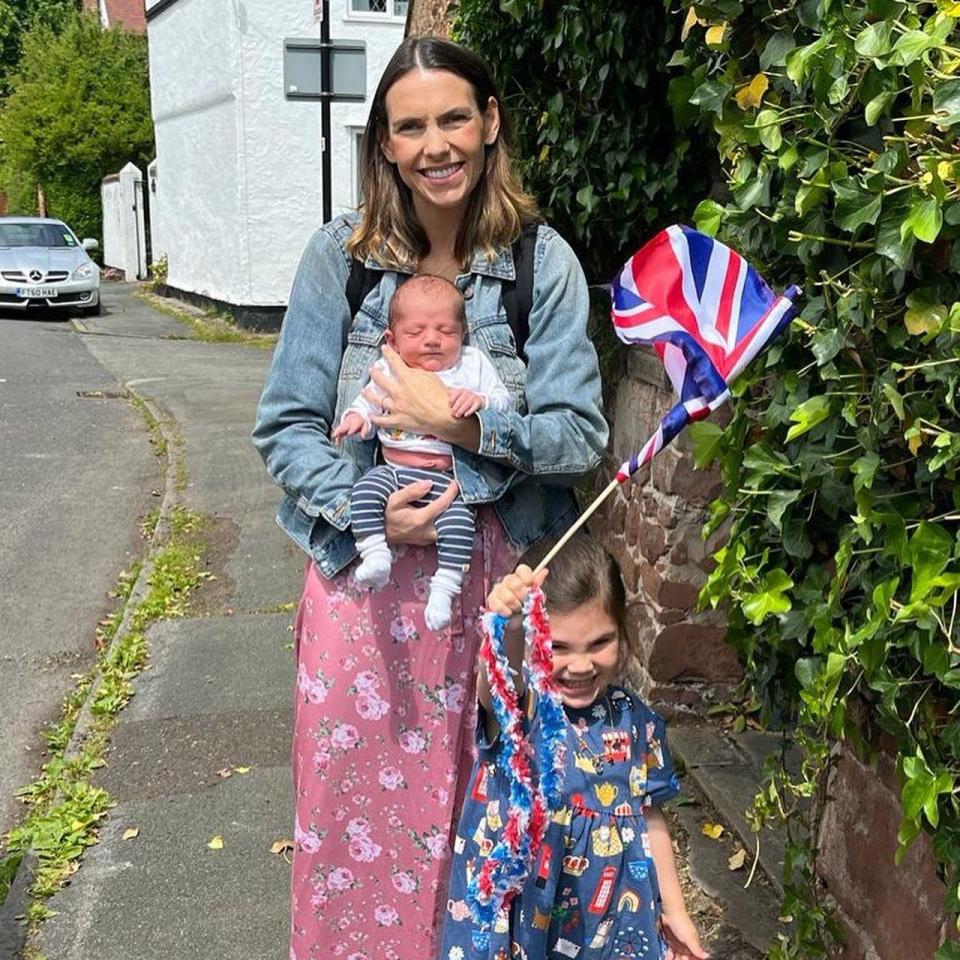No doctor, no midwife – why more women are giving birth alone

- Oops!Something went wrong.Please try again later.
While Lucy Sharp was giving birth to her second child – a son – at her home in May 2022, her three-year-old daughter Matilda peered around the living room door to see what was going on. She saw her mother in the birthing pool, surrounded by candles, the Bette Midler song Wind Beneath My Wings playing in the background.
“It was around 7am, and Matilda had just woken up,” Lucy says. “I told her, ‘Your baby brother’s head is out. Do you want to see him being born?’ and she sat on the sofa and watched. When he came out I reached under the water and I could see the umbilical cord was around his neck, so I unravelled it under the water two or three times, and then brought him up to the surface and held him to my chest. I could tell straight away he was absolutely fine.”
Lucy’s story is not always typical of home births, though. She had no midwife with her, not even a doula, and she had chosen to forgo all kinds of medical support – something known as “freebirthing”.
Last week, health leaders highlighted concerns over the practice, amid a rise of women giving birth without medical assistance. Although exact figures are not known, freebirths are believed to have increased since the Covid-19 pandemic.
Responding to the concerns, Prof Asma Khalil, Vice President of the Royal College of Obstetricians and Gynaecologists, said: “Women and people should have the right to give birth in an environment in which they feel comfortable, and should be supported in their birth choice.
“However, safety is paramount, and while most births are uncomplicated, advising women about the potential risks is crucial for informed decision making. Women opting for unassisted births need awareness of the potential challenges and delays in accessing medical assistance if complications arise, as emergency intervention may be necessary, even for those at low risk.”
Some experts also believe UK maternity failings are behind the rise. In November, the Care Quality Commission deemed two-thirds of maternity units not safe enough, partly blaming it on midwife shortages.
Last week the charity Birthrights said that while the decision to have an unassisted birth is “completely lawful” and for many “an empowering decision”, they are “deeply concerned that some people are opting for an unassisted birth because they have been left with no other option, and for some people the decision comes from a deep fear of the maternity system”.
Lucy, 41, opted for a midwife-supported home birth with Matilda, who was born in 2018. Unusually, however, she hadn’t even heard of home births until she was 30 weeks pregnant.
During her first pregnancy she and her husband Gray, 44, were living in London. Lucy was under the care of London’s Chelsea and Westminster Hospital, whose staff she describes as “amazing”. Halfway through the pregnancy, the couple moved to Chester and discovered their local hospital, the Countess of Chester Hospital, was investigating a spate of baby deaths. In August 2023, Lucy Letby, a former neonatal nurse at the hospital, was sentenced to life for the murder and attempted murder of babies in her care.
“The hospital wasn’t all over the news at this point – Matilda was born in 2018 – but we read about the deaths, and around the same time a friend told us about home births,” says Lucy. She started planning to give birth at home with a midwife present.

Her first twinge came at 8pm while making fajitas, and by 2.45am Lucy had given birth to Matilda in a birthing pool at home. Later that day the new family visited her parents before going to a “fancy bar for a glass of champagne. Matilda was nine hours old, and I felt amazing.”
By the time she was pregnant with Louis in 2021, Lucy says she had decided she would “not be stepping foot in a hospital”. She had experienced multiple miscarriages between her pregnancies, having a number of surgical removals, and had “a real anxiety” around hospitals.
She says: “I wanted another home birth, and I had also read that during Covid lots of women who wanted them had been let down by their midwife at the last minute and transferred to hospital.”
The couple decided to pay for a private midwife service, where blood tests were done at home and scans in private clinics. However, Lucy didn’t bond with the midwives. “I was 22 weeks pregnant and they were coming round too frequently. They detected some sugar in my urine and started talking about gestational diabetes (GD), but I’d had a chocolate croissant just before they arrived.
“I kept saying to them, ‘Why are you being so negative?’ I was all about the positivity. I had done this before. I said I wouldn’t go to the Countess [of Chester Hospital, if anything went wrong], and they said, ‘You’ll go where the ambulance takes you’.”
Eventually, Lucy said there would be no more tests or bump measurements and no monitoring in labour, something she said would “completely spoil the vibe”. She terminated her contract with them at 28 weeks pregnant, paying around £2,600 (the full service up to birth would have cost £3,800).

From then on, Lucy listened to podcasts about breech births, where a baby lies feet or bottom first in the womb, rather than head down (Matilda had been breech, but moved into the right position during labour). She joined freebirth communities online (there are currently over 95,000 hashtags for #freebirth on Instagram alone). “I felt from the bottom of my heart that I could do this,” she says.
“I found a wonderful doula called Jemima, who knew about techniques like standing and swaying, which gets your baby into the right position for birth. She recommended I see a chiropractor to make sure my birth canal was in the right position, and talked Gray through lots of techniques. I had my essential oils, my homeopathic kit, and my affirmation cards. One read, ‘Floppy face = floppy fanny’. Apparently if your jaw is tense, so is your pelvis, which makes birth harder.”
On May 19 2022 at 2.30am, Lucy felt a twinge. Gray filled the pool up and, with her playlist still going, Louis was born just after 7am with big sister Matilda looking on. “It was a little while until he cried, but I was really relaxed,” says Lucy. “Matilda joined us in the pool and had a splash around. Then Gray looked up how to cut the cord on YouTube, using a sterilised cord cutting kit we had bought.”
Lucy then emailed her local hospital to tell them Louis had been born. It is legal for a woman to give birth unattended by a midwife or healthcare professional, but you must register your baby within 42 days of birth.
Of her decision to do a free-birth, Lucy says the few friends and family she told were supportive. However, her neighbour, a doctor, did question the decision, and her father also expressed anxieties.
“But when an animal gives birth it goes to a dark, quiet place, where it feels safe and where it’s not being watched,” she says. “I’m not a rulebreaker by nature. But I have read so many horror stories about women being treated badly in labour, with a cascade of interventions, or just left alone. Whereas I felt respected and cared for, and safe. I think women know their own bodies better than anybody.”

